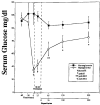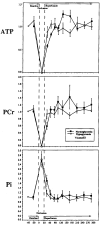Hypoglycemia prevents increase in lactic acidosis during reperfusion after temporary cerebral ischemia in rats
- PMID: 8771092
- PMCID: PMC2744691
- DOI: 10.1002/nbm.1940080406
Hypoglycemia prevents increase in lactic acidosis during reperfusion after temporary cerebral ischemia in rats
Abstract
Sequential 31P and 1H MRS was used to measure cerebral phosphate metabolites, intracellular pH, and lactate in normoglycemic and hypoglycemic rats during 30 min of complete cerebral ischemia and 5.5 h of reperfusion. These results were correlated with brain levels of free fatty acids (FFAs), excitatory amino acids, cations, and water content at death. The lactate/N-acetyl aspartate ratio was not significantly different between groups before or during occlusion. During reperfusion, the ratio was higher in normoglycemic rats from 3 to 85 min (p < or = 0.05), and recovery time was faster in hypoglycemic rats (29 vs 45 min; p = 0.04), suggesting reduced lactate production and faster recovery of aerobic metabolism. During occlusion, significant but comparable decrease of intracellular pH occurred in each group. Intracellular pH was higher in hypoglycemic rats at 140 min and 260 min of reperfusion. Water content, Na and K+ concentrations, and FFA and excitatory amino acid levels were not significantly different between groups, but hypoglycemic rats had less depletion of levels of Mg2+ (p = 0.011). These results show that hypoglycemia has a limited but potentially beneficial effect on postischemic lactic acidosis.
Figures





Similar articles
-
Effects of hyperglycemia on the time course of changes in energy metabolism and pH during global cerebral ischemia and reperfusion in rats: correlation of 1H and 31P NMR spectroscopy with fatty acid and excitatory amino acid levels.J Cereb Blood Flow Metab. 1992 May;12(3):456-68. doi: 10.1038/jcbfm.1992.63. J Cereb Blood Flow Metab. 1992. PMID: 1569139
-
Effect of dichloroacetate on recovery of brain lactate, phosphorus energy metabolites, and glutamate during reperfusion after complete cerebral ischemia in rats.J Cereb Blood Flow Metab. 1992 Nov;12(6):1030-8. doi: 10.1038/jcbfm.1992.140. J Cereb Blood Flow Metab. 1992. PMID: 1356994
-
Mapping of lactate and N-acetyl-L-aspartate predicts infarction during acute focal ischemia: in vivo 1H magnetic resonance spectroscopy in rats.Neurosurgery. 1996 Jan;38(1):121-9; discussion 129-30. doi: 10.1097/00006123-199601000-00030. Neurosurgery. 1996. PMID: 8747960
-
Epileptic brain damage: pathophysiology and neurochemical pathology.Adv Neurol. 1986;44:813-47. Adv Neurol. 1986. PMID: 2871725 Review.
-
Cerebral metabolic studies in vivo by combined 1H/31P and 1H/13C NMR spectroscopic methods.Acta Neurochir Suppl (Wien). 1993;57:9-20. doi: 10.1007/978-3-7091-9266-5_2. Acta Neurochir Suppl (Wien). 1993. PMID: 8421959 Review.
Cited by
-
Inhibition of G protein-coupled receptor 81 (GPR81) protects against ischemic brain injury.CNS Neurosci Ther. 2015 Mar;21(3):271-9. doi: 10.1111/cns.12362. Epub 2014 Dec 11. CNS Neurosci Ther. 2015. PMID: 25495836 Free PMC article.
-
Effect of hypertransfusion on the gastrointestinal tract after cardiac arrest in a porcine model.World J Emerg Med. 2012;3(1):49-54. doi: 10.5847/wjem.j.issn.1920-8642.2012.01.009. World J Emerg Med. 2012. PMID: 25215039 Free PMC article.
-
Lactate Metabolism and Lactylation Modification: New Opportunities and Challenges in Cardiovascular Disease.MedComm (2020). 2025 Jul 1;6(7):e70269. doi: 10.1002/mco2.70269. eCollection 2025 Jul. MedComm (2020). 2025. PMID: 40599233 Free PMC article. Review.
References
-
- Ibayashi S, Fujishima M, Sadoshima S, Yoshida F, Shiokawa O, Ogata J, Omae T. Cerebral blood flow and tissue metabolism in experimental cerebral ischemia of spontaneously hypertensive rats with hyper-, normo-, and hypoglycemia. Stroke. 1986;17:261–266. - PubMed
-
- Kozuka M, Smith ML, Siesjö BK. Preischemic hyperglycemia enhances postischemic depression of cerebral metabolic rate. J. Cereb. Blood Flow Metab. 1989;9:478–490. - PubMed
-
- Plum F, Kraig RP, Pulsinelli WA. Compartmentation of acid-base in brain during complete ischemia. Neurochem. Pathol. 1988;9:139–144. - PubMed
-
- Zasslow MA, Pearl RG, Shuer LM, Steinberg GK, Lieberson RE, Larson CP., Jr Hyperglycemia decreases acute neuronal ischemic changes after middle cerebral artery occlusion in cats. Stroke. 1989;20:519–523. - PubMed
-
- Bolas NM, Rajagopalan B, Mitsumori F, Radda GK. Metabolic changes during experimental cerebral ischemia in hyperglycemic rats, observed by 31P and 1H magnetic resonance spectroscopy. Stroke. 1988;19:608–614. - PubMed
Publication types
MeSH terms
Substances
Grants and funding
LinkOut - more resources
Full Text Sources
Medical

